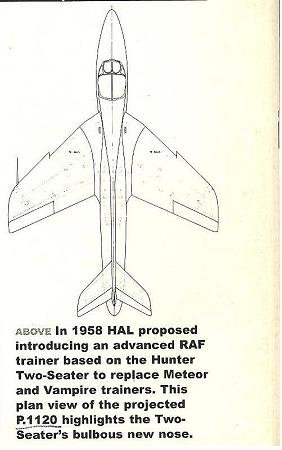You are using an out of date browser. It may not display this or other websites correctly.
You should upgrade or use an alternative browser.
You should upgrade or use an alternative browser.
Hawker P.1120
- Thread starter hesham
- Start date
- Joined
- 6 September 2006
- Messages
- 4,838
- Reaction score
- 9,481
The P.1120 looks almost identical to the P.1101 Hunter T.7. I am assuming it is an export version intended for India (HAL = Hindustan Aeronautics Limited). Although they had ordered the more powerful T.66 in 1957 with the Avon 200-series engine. Its possible the date in the caption is incorrect and is a T.66 precursor (or the T.66 itsellf), of if the date is correct then it might be a follow-on T.66 project for Indian licence-construction/conversion.
- Joined
- 27 December 2005
- Messages
- 17,753
- Reaction score
- 26,468
Hawker Aircraft Limited seems more likely for an RAF trainer....
Last edited:
- Joined
- 27 December 2005
- Messages
- 17,753
- Reaction score
- 26,468
According to Francis K. Mason P.1120 was Hawker's submission for an advanced trainer (Specification T185D) which was won by Folland with the Gnat T.1. I expect there's something on it in the T185D papers at Kew:
 discovery.nationalarchives.gov.uk
discovery.nationalarchives.gov.uk
Search results: T185D trainer | The National Archives
The official archive of the UK government. Our vision is to lead and transform information management, guarantee the survival of today's information for tomorrow and bring history to life for everyone.
Last edited:
- Joined
- 6 September 2006
- Messages
- 4,838
- Reaction score
- 9,481
According to Francis K. Mason P.1120 was Hawker's submission for an advanced trainer (Specification T185D) which was won by Folland with the Gnat T.1. I expect there's something on it in the T185D papers at Kew:
Whoops, yes I would concede HAL as being Hawker Aircraft Limited.
I am currently doing fairly extensive research on RAF trainers (hence my interest being piqued here) and I have found no mention of the P.1120 (or any Hunter development) in connection with T.185D in the Kew files. By 1958 work was well underway on the Gnat trainer to fulfil T.185D and T.185 seems to have been written around the Gnat in response to studies undertaken by Folland in 1956 at the MoS's behest.
Maybe this was an early attempt to sell a T.66 to the RAF? By 1961 the RAF was certainly interested in the T.66 as a TSR.2 lead-in trainer.
One thing that seems to be recurring is that the info on project studies in the old Putnams is often showing up as incorrect or mystifying.
- Joined
- 27 December 2005
- Messages
- 17,753
- Reaction score
- 26,468
According to Francis K. Mason P.1120 was Hawker's submission for an advanced trainer (Specification T185D) which was won by Folland with the Gnat T.1. I expect there's something on it in the T185D papers at Kew:
Whoops, yes I would concede HAL as being Hawker Aircraft Limited.
I am currently doing fairly extensive research on RAF trainers (hence my interest being piqued here) and I have found no mention of the P.1120 (or any Hunter development) in connection with T.185D in the Kew files. By 1958 work was well underway on the Gnat trainer to fulfil T.185D and T.185 seems to have been written around the Gnat in response to studies undertaken by Folland in 1956 at the MoS's behest.
Maybe this was an early attempt to sell a T.66 to the RAF? By 1961 the RAF was certainly interested in the T.66 as a TSR.2 lead-in trainer.
One thing that seems to be recurring is that the info on project studies in the old Putnams is often showing up as incorrect or mystifying.
The P.1120 information is ultimately from Hawker records. Its possible P.1120 was an unsolicited bid, or even never submitted. The two-seat P.1101 was developed to Specification T.157D.- P.1120 might have got filed there, or (as an unsolicited bid) not retained.
AVIA 65/634
T157D Hawker Aircraft Ltd: dual version of Hawker Hunter | The National Archives
The official archive of the UK government. Our vision is to lead and transform information management, guarantee the survival of today's information for tomorrow and bring history to life for everyone.
- Joined
- 27 December 2005
- Messages
- 17,753
- Reaction score
- 26,468
T.157D for P.1101 / Hunter T.7 was issued in January 1955.
Requirement T.185D was issued in January 1958. This is later than the Hawker P.1120 submission (it dates to 1957) so it predates the Gnat requirement. However I know from my research that draft requirements and specifications were often cirulated, and rumours of forthcoming requirements would often reach aircraft companies in advance.
Hawker could reasonably have expected Hunter T.7 to replace all Vampire T.11s (built to Specification T.111) but it only replaced part of the Vampire fleet, for weapons instruction but not advanced trainer roles. Failure to order more T.7s left an opening for the Gnat. The fighter Gnat was only about half the cost of a Hunter to buy.
P.1120 was probably based on a later Hunter standard than T.7.
Requirement T.185D was issued in January 1958. This is later than the Hawker P.1120 submission (it dates to 1957) so it predates the Gnat requirement. However I know from my research that draft requirements and specifications were often cirulated, and rumours of forthcoming requirements would often reach aircraft companies in advance.
Hawker could reasonably have expected Hunter T.7 to replace all Vampire T.11s (built to Specification T.111) but it only replaced part of the Vampire fleet, for weapons instruction but not advanced trainer roles. Failure to order more T.7s left an opening for the Gnat. The fighter Gnat was only about half the cost of a Hunter to buy.
P.1120 was probably based on a later Hunter standard than T.7.
Last edited:
- Joined
- 27 December 2005
- Messages
- 17,753
- Reaction score
- 26,468
P.1120 designation must have been allocated in June 1956 (P.1121 is from this month, P.1116 from only a few weeks earlier). One criticism of the T.7 made by Folland was it did not use the new OR.946 IFICS cockpit instrumentation (used on later Lightnings, partly on Buccaneer, proposed for P.1121) while their Fo.144 proposal did.
Last edited:
- Joined
- 27 December 2005
- Messages
- 17,753
- Reaction score
- 26,468
According to From Lysander to Lightning it was Air Marshal Sir Richard Atcherley (AOC in C, Flying Training Command) who saw a gap between the Jet Provost and the Hunter T.7 and Folland were informed of a future requirement for an advanced trainer.
- Joined
- 6 September 2006
- Messages
- 4,838
- Reaction score
- 9,481
P.1120 designation must have been allocated in June 1956 (P.1121 is from this month, P.1116 from only a few weeks earlier). One criticism of the T.7 made by Folland was it did not use the new OR.946 IFICS cockpit instrumentation (used on later Lightnings, partly on Buccaneer, proposed for P.1121) while their Fo.144 proposal did.
Petter was never completely straight about these things. It soon turned out the full OR946 panel wouldn't fit in the Gnat and he even tried convincing the RAF they didn't really need ILS in the Gnat to cover the fact he couldn't fit it in easily. The Gnat files raise a few chuckles.
Similar threads
-
Hawker de Havilland P.17 Vampire derivative Project
- Started by hesham
- Replies: 2
-
-
The Hawker P.1052, P.1072 and P.1081.
- Started by blackkite
- Replies: 12
-
AST.362: British Strike Trainers
- Started by Jason Dykstra (Wyvern)
- Replies: 8
-
Question about HDH-Australia Projects ?
- Started by hesham
- Replies: 0

